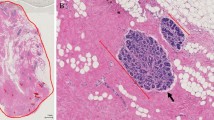Abstract
Background Ductal lavage (DL) allows repeat sampling of breast epithelium for serial observation in a chemoprevention setting; however, the reproducibility of duct cannulation, cell yield and cytology has not been addressed. Methods We conducted a Phase 2 trial, wherein high risk women chose tamoxifen treatment or observation following an entry DL procedure. We present data from the non-intervention arm of our study to assess the reproducibility of cannulation, cell yield, and cytologic diagnosis from DL of the same duct at two time-points. Inter-observer variability was assessed by a blinded review of Papanicoloau-stained slides by two cytopathologists. Results Sixty-five women had a successful lavage of 187 ducts at baseline and chose observation; 63/65 (97%) had a successful lavage 6 months later. Successful recannulation of the same duct was accomplished in 63 women (97%) and162 ducts (87%). Total epithelial cell yields ≥100 were obtained from 57/65 women (88%) and 129/187 ducts (69%) at baseline, and 46/63 women (73%) and 80/162 ducts (49%) at both time-points. Cytologic diagnosis was reproducible in 27/63 (43%) women and 77/162 (48%) ducts. Inter-observer variability for cytologic diagnosis between two observers showed good agreement (κ = 0.62). Conclusions Recannulation and lavage of the same duct after a 6 month interval can be achieved with high frequency; however, reproducibility of cell yield and cytologic findings from the same duct is sub-optimal, leading to significant attrition of evaluable subjects. The utility of DL for the serial monitoring of breast epithelium is therefore limited.



Similar content being viewed by others
References
Dooley WC, Ljung BM, Veronesi U et al (2001) Ductal lavage for detection of cellular atypia in women at high risk for breast cancer. J Natl Cancer Inst 93:1624–1632
O’Shaughnessy JA, Ljung BM, Dooley WC et al (2002) Ductal lavage and the clinical management of women at high risk for breast carcinoma: a commentary. Cancer 94:292–298
Khan SA, Baird C, Staradub VL, Morrow M (2002) Ductal lavage and ductoscopy: the opportunities and the limitations. Clin Breast Cancer 3:185–191
Gail MH, Brinton LA, Byar DP et al (1989) Projecting individualized probabilities of developing breast cancer for white females who are being examined annually [see comments]. J Natl Cancer Inst 81:1879–1886
Claus EB, Risch NJ, Thompson WD (1990) Age at onset as an indicator of familial risk of breast cancer. Am J Epidemiol 131:961–972
Marshall PN (1983) Papanicolaou staining—a review. Microsc Acta 87:233–243
Khan SA, Wiley EL, Rodriguez N et al (2004) Ductal lavage findings in women with known breast cancer undergoing mastectomy. J Natl Cancer Inst 96:1510–1517
Landis R, Koch G (1977) The measurement of observer agreement for categorical data. Biometrics 33:671–679
Shaughnessy JA, Kelloff GJ, Gordon GB et al (2002) Treatment and prevention of intraepithelial neoplasia: an important target for accelerated new agent development: recommendations of the American association for cancer research task force on the treatment and prevention of intraepithelial neoplasia. Clin Cancer Res 8:314–346
Dooley WC, Ljung B-M, Veronesi U et al (2001) Ductal lavage for detection of cellular atypia in women at high risk for breast cancer. J Natl Cancer Inst 93:1624–1632
Johnson-Maddux A, Ashfaq R, Cler L et al (2005) Reproducibility of cytologic atypia in repeat nipple duct lavage. Cancer 103:1129–1136
Hartman AR, Daniel BL, Kurian AW et al (2004) Breast magnetic resonance image screening and ductal lavage in women at high genetic risk for breast carcinoma. Cancer 100:479–489
Visvanathan K, Santor D, Ali SZ, Hong IS, Davidson NE, Helzlsouer KJ (2006) The importance of cytologic intrarater and interrater reproducibility: the case of ductal lavage. Cancer Epidemiol Biomarkers Prev 15:2553–2556
Brogi E, Robson M, Panageas KS, Casadio C, Ljung BM, Montgomery L (2003) Ductal lavage in patients undergoing mastectomy for mammary carcinoma: a correlative study. Cancer 98:2170–2176
Acknowledgements
This work was supported by the Bluhm Family Program for Breast Cancer Early Detection and Prevention, and NIH/NCI P50 CA89018-02 (Avon Progress for Patients Supplement); HAL is currently supported by NCI grant R25 CA100600.
Author information
Authors and Affiliations
Corresponding author
Rights and permissions
About this article
Cite this article
Patil, D.B., Lankes, H.A., Nayar, R. et al. Reproducibility of ductal lavage cytology and cellularity over a six month interval in high risk women. Breast Cancer Res Treat 112, 327–333 (2008). https://doi.org/10.1007/s10549-007-9861-8
Received:
Accepted:
Published:
Issue Date:
DOI: https://doi.org/10.1007/s10549-007-9861-8




